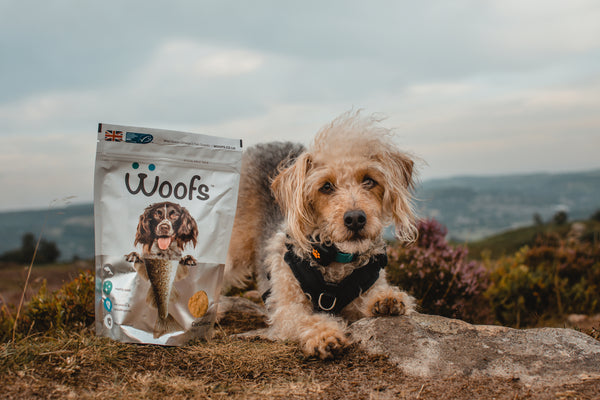Account

Feeding your dog: How much and how often?

For every new dog owner, arguably the most common questions are ‘how much should I be feeding my dog?’ and ‘how many meals should my dog have per day?’. For obvious reasons, the answers to these questions vary.
We decided to consult WOOFS’ very own Canine Nutritionist, Moddie Lambert.
A DOG'S DAILY CALORIE REQUIREMENTS
On a daily basis, dogs need about 30 calories per pound of body weight in order to maintain their current weight. Small and active dogs can require as much as 40 calories per pound, whereas larger breeds might only require as little as 20 calories per day.
Obviously, there are other factors that can influence how much your dog should be eating, which we’ll speak about later.
Moddie was kind enough to provide us with the chart below, which outlines how many calories a day your dog should be eating (approximately), depending on their target weight.
TARGET WEIGHT |
CALORIES |
| 5.5 lb (2.5 kg) | 250 |
| 11 lb (5 kg) | 450 |
| 22 lb (10 kg) | 750 |
| 33 lb (15 kg) | 1000 |
| 44 lb (20 kg) | 1250 |
| 55 lb (25 kg) | 1500 |
| 66 lb (30 kg) | 1700 |
| 77 lb (35 kg) | 1880 |
| 88 lb (40 kg) | 2100 |
| 99 lb (45 kg) | 2300 |
| 110 lb (50 kg) | 2500 |
WHEN MIGHT CALORIE INTAKE VARY?
1. Activity levels
Dogs that are regularly exercised will require more calories (lucky dogs) because they'll be burning more. Fish treats are fantastic for training and exercise purposes, as the Omega–3 fatty acids can benefit joint mobility, healthy vision and brain functionality.
Less active dogs (especially in hot climates), will require fewer calories to maintain their optimal weight. Again, as fish is super low in calories compared to meat-based treats, it might be your best option.
2. When a dog's underweight
If you're trying to help your dog gain weight, then you'll need to make sure they're consuming more calories than what they're burning. In this case, supplementing meals and extra treats is the best strategy, but always in moderation.
3. When a dog's overweight
Although feeding fewer calories might seem like the best strategy to help your dog lose weight, you can actually gain better results by increasing exercise and reducing portion sizes while increasing the number of meals per day (to help spread them out and boost metabolism).
4. When a dog's been neutered
Neutered dogs often require fewer calories, so it's recommended to decrease their calorie intake by a quarter, then keep an eye on their weight.
If they're losing weight, gradually increase the amount they're eating until they're maintaining a healthy weight. If they're gaining weight, then further reduce how much you're feeding your dog.
5. Age
Puppies are basically cuter and more energetic versions of the Duracell bunny. For that reason they'll require far more calories. It's super important to listen to breeders or rescue shelters about what to feed your puppy at first, as they're already going to have enough shocks when adapting to their new environments.
Did you know? The Omega–3 and Omega–6 found in fish aids growth and general health development in puppies.
As dogs become older and less active, they need to eat about 20% less than when they were younger. This doesn't necessarily mean that you have to feed them less, as you can easily adapt the food you do feed them so that it has less fat and fewer calories. (Did we ever tell you about the benefits of our fish treats?!)
6. Pregnancy
For the first two trimesters, not much will change in terms of calories requirements for a pregnant dog. However, in the third trimester, they'll likely require 30-60% more than usual. As you'd expect, it can vary from dog to dog so keep an eye on your dog's weight throughout pregnancy and add or take away from diets accordingly.
7. Post-pregnancy
The energy requirements of a lactating mother might surprise you...
Their energy requirements after whelping (giving birth) is actually more than whilst they're pregnant. At their highest level (after 3-5 weeks), she might require 2 to 4 times the energy of a healthy adult. This should all go back to normal after about two months or so.
There are even more factors that can influence how much and how often your dog should eat, but the very best way to determine your dog's individual requirements is to regularly monitor their weight and what they're eating. In addition to this, make sure to consult experts, such as vets and canine nutritionists, like Moddie.
Thanks for reading!

Our 100% natural and sustainable fish treats are super low in calories and super high in everything great for dogs. Click here to see our full collection of yummy treats.
If you have any further questions, please feel free to send us an email or message us on Instagram.




